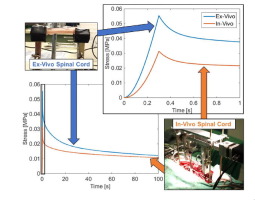Acta Biomaterialia ( IF 9.4 ) Pub Date : 2017-12-26 , DOI: 10.1016/j.actbio.2017.12.024 Nicole L Ramo 1 , Snehal S Shetye 2 , Femke Streijger 3 , Jae H T Lee 4 , Kevin L Troyer 5 , Brian K Kwon 6 , Peter Cripton 7 , Christian M Puttlitz 8

|
Despite efforts to simulate the in-vivo environment, post-mortem degradation and lack of blood perfusion complicate the use of ex-vivo derived material models in computational studies of spinal cord injury. In order to quantify the mechanical changes that manifest ex-vivo, the viscoelastic behavior of in-vivo and ex-vivo porcine spinal cord samples were compared. Stress-relaxation data from each condition were fit to a non-linear viscoelastic model using a novel characterization technique called the direct fit method. To validate the presented material models, the parameters obtained for each condition were used to predict the respective dynamic cyclic response. Both ex-vivo and in-vivo samples displayed non-linear viscoelastic behavior with a significant increase in relaxation with applied strain. However, at all three strain magnitudes compared, ex-vivo samples experienced a higher stress and greater relaxation than in-vivo samples. Significant differences between model parameters also showed distinct relaxation behaviors, especially in non-linear relaxation modulus components associated with the short-term response (0.1 to 1 second). The results of this study underscore the necessity of utilizing material models developed from in-vivo experimental data for studies of spinal cord injury, where the time-dependent properties are critical. The ability of each material model to accurately predict the dynamic cyclic response validates the presented methodology and supports the use of the in-vivo model in future high-resolution finite element modeling efforts.
Statement of Significance
Neural tissues (such as the brain and spinal cord) display time-dependent, or viscoelastic, mechanical behavior making it difficult to model how they respond to various loading conditions, including injury. Methods that aim to characterize the behavior of the spinal cord almost exclusively use ex-vivo cadaveric or animal samples, despite evidence that time after death affects the behavior compared to that in a living animal (in-vivo response). Therefore, this study directly compared the mechanical response of ex-vivo and in-vivo samples to quantify these differences for the first time. This will allow researchers to draw more accurate conclusions about spinal cord injuries based on ex-vivo data (which are easier to obtain) and emphasizes the importance of future in-vivo experimental animal work.
中文翻译:

脊髓体内和体外粘弹性行为的比较
尽管努力模拟体内环境,但死后降解和缺乏血液灌注使得在脊髓损伤的计算研究中使用离体衍生材料模型变得复杂。为了量化离体表现的机械变化,比较了体内和离体猪脊髓样品的粘弹性行为。使用称为直接拟合法的新颖表征技术将每种条件下的应力松弛数据拟合到非线性粘弹性模型。为了验证所提出的材料模型,针对每种条件获得的参数用于预测各自的动态循环响应。离体和体内样品均表现出非线性粘弹性行为,随着施加的应变,松弛度显着增加。然而,在比较所有三个应变大小时,离体样品比体内样品经历了更高的应力和更大的松弛。模型参数之间的显着差异还表现出明显的松弛行为,尤其是与短期响应(0.1 至 1 秒)相关的非线性松弛模量分量。这项研究的结果强调了利用根据体内实验数据开发的材料模型来研究脊髓损伤的必要性,其中时间依赖性特性至关重要。每个材料模型准确预测动态循环响应的能力验证了所提出的方法,并支持在未来高分辨率有限元建模工作中使用体内模型。
重要性声明
神经组织(例如大脑和脊髓)表现出时间依赖性或粘弹性机械行为,因此很难模拟它们如何响应各种负载条件(包括损伤)。旨在表征脊髓行为的方法几乎完全使用离体尸体或动物样本,尽管有证据表明与活体动物相比,死后时间会影响行为(体内反应)。因此,本研究首次直接比较离体和体内样品的机械响应,以量化这些差异。这将使研究人员能够根据离体数据(更容易获得)得出关于脊髓损伤的更准确的结论,并强调未来体内实验动物工作的重要性。











































 京公网安备 11010802027423号
京公网安备 11010802027423号